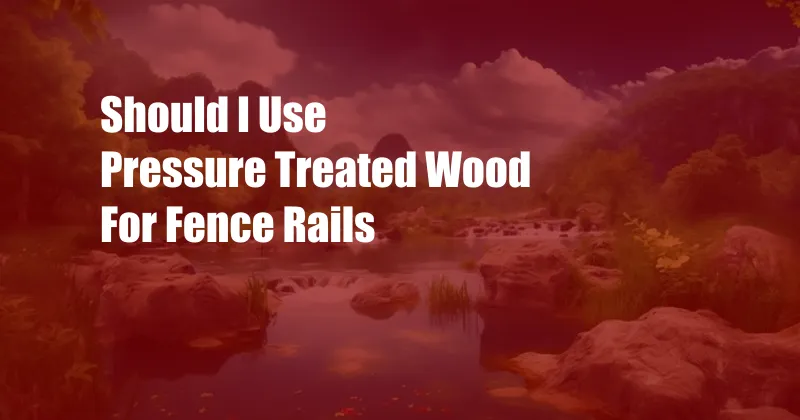
Should I Use Pressure-Treated Wood for Fence Rails?
When constructing a fence, selecting the right materials is crucial for durability and longevity. As a seasoned DIY enthusiast, I’ve encountered several projects that involved the use of pressure-treated wood, and its effectiveness in withstanding the elements has left me impressed. However, understanding when it’s the optimal choice for fence rails is essential. So, let’s delve into the pros and cons of using pressure-treated wood for this specific purpose.
Treated vs. Untreated Wood
Before we explore the suitability of pressure-treated wood for fence rails, let’s clarify the distinction between treated and untreated wood. Untreated wood is simply lumber that has not undergone any chemical treatment. While it is more susceptible to rot, decay, and insect damage, it is also more environmentally friendly.
Pressure-treated wood, on the other hand, undergoes a process where chemicals are infused into the wood under high pressure. This treatment enhances the wood’s resistance to rot, decay, and insect infestations. However, it’s important to note that not all pressure-treated wood is created equal. There are different types of treatment formulations, and each has its intended use.
Pressure-Treated Wood for Fence Rails
When considering the use of pressure-treated wood for fence rails, it’s important to weigh the following factors:
-
Durability: Pressure-treated wood is designed to withstand the elements, making it an excellent choice for outdoor applications such as fences. It can resist rot, decay, and insect damage, ensuring that your fence remains sturdy for many years to come.
-
Environmental Concerns: Pressure-treated wood is treated with chemicals that can be harmful to humans and the environment. These chemicals must be disposed of properly, and precautions should be taken during handling and installation.
-
Cost: Pressure-treated wood is generally more expensive than untreated wood. However, considering its increased durability, it may prove to be a more cost-effective option in the long run.
Considerations for Fence Rail Usage
In addition to the above factors, there are specific considerations when using pressure-treated wood for fence rails:
-
Ground Contact: Pressure-treated wood is ideal for fence rails that will have direct contact with the ground, as it is more resistant to water absorption and decay.
-
Rail Spacing: If the fence rails are spaced widely apart, untreated wood may suffice. However, for fences with closely spaced rails, pressure-treated wood is recommended to prevent rot and decay.
-
Chemical Leaching: Pressure-treated wood can leach chemicals over time, which can be a concern if the fence is located near a water source or edible plants.
Expert Tips and Advice
Based on my experiences and research, I offer the following tips and advice when considering pressure-treated wood for fence rails:
-
Choose the Right Treatment Type: Not all pressure-treated wood is suitable for fence rails. Select a type that is specifically designed for ground contact, such as ACQ (alkaline copper quaternary).
-
Use Proper Installation Techniques: Install pressure-treated wood rails with galvanized fasteners to prevent corrosion. Ensure that the rails are properly spaced and elevated off the ground to minimize water absorption.
-
Handle and Dispose Safely: Wear protective gear when handling pressure-treated wood, and dispose of scraps and sawdust properly according to local regulations.
-
Consider Alternative Options: If environmental concerns are a priority, explore alternative materials such as cedar, redwood, or composite lumber. These options may be more environmentally friendly and can provide similar durability.
Frequently Asked Questions
Q: Is pressure-treated lumber safe for vegetable gardens?
A: No, pressure-treated wood should not be used in direct contact with edible plants or water sources due to potential chemical leaching.
Q: Can I paint pressure-treated wood?
A: Yes, you can paint pressure-treated wood. However, allow the wood to dry thoroughly and apply a primer specifically designed for pressure-treated lumber before painting.
Q: How long will pressure-treated wood fence rails last?
A: The lifespan of pressure-treated wood fence rails can vary depending on the treatment type, environmental conditions, and maintenance practices. On average, they can last for 15 to 25 years or more.
Conclusion
Deciding whether to use pressure-treated wood for fence rails requires careful consideration of durability, cost, and environmental concerns. By weighing these factors and following expert advice, you can make an informed decision that will ensure a long-lasting and visually appealing fence for your property.
Are you planning to build a fence using pressure-treated wood? Share your questions and thoughts in the comments below.